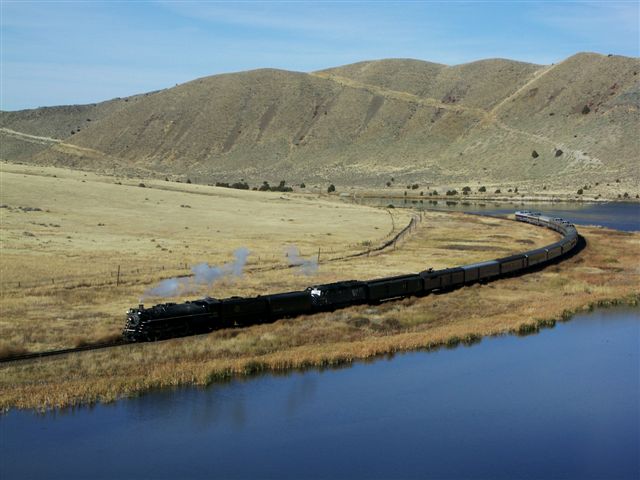
Welding the broken lubricator bracket at Missoula, MT Saturday night.
Martin Burwash photo.

Photographing My Ride Although I took two cameras along I actually took very few photos. There were several reasons for that.1. I have gone places and done things before where I've taken a lot of pictures. Sometimes after those outings it seems as though I remember the whole experience only as it was seen through a viewfinder. I wanted to soak up everything about my ride on the 700. I knew it would be a once in a lifetime experience. I wanted the memories to be of the sights, the sounds, the feel, the smell, not just scenes through a viewfinder.
2. As I have said before in my posts, auto-focus cameras do not always work well from moving locomotives. When the entire outside world is moving the cameras cannot find anything to focus on.
3. My 35mm camera has only an ancient, thus large, 35mm-110mm telephoto lens. I found it to be quite unwieldy in the cab. My eyes are not what they used to be and trying to manually focus that camera while on the move proved to be difficult.So I took fewer pictures than I would have liked and fewer still came out in focus. However in reviewing the pictures I find that there are only so many shots from the cab that you can look at before they all start looking the same so maybe there is no loss.
While attempting a few of the cab shots I decided the best camera for the job would be a good quality "snapshot" camera. Either digital or film but one with a fixed focus lens.
The pictures with my ride report are not meant to be photogenic wonders. They are meant to support the text. If you want pretty-pictures there are hundreds of beautiful professional quality photos of the SP&S 700 on this trip on the internet.
When we passed the SP&S 700 at Billings Monday night I tried to take a quick grab shot of the loco lit by my headlights. Later I saw it didn't work out. Just blurry lights and blackness. It is one of those "what could have been" shots. The center light is the headlight. The others are the two white class lights and the number boards. You can see the front of the smokebox and the left cylinder illuminated by our headlights. Oh what could have been.

Photos of me I have been trying to locate at least one photo taken from the outside that clearly shows me running the 700. I have not been very successful. If any of you have a photo taken between the departure at Clarkston and the stop at Townsend I'd be interested in seeing them.This picture is a frame from a short video clip sent to me by Mark Minckler. It is the only picture I have which was taken from outside that actually shows me in the cab window running the 700. Unfortunately when blown up to this size it is quite blocky so you'll have to take my word that it is me. Pilot Bob Bateman is standing in the gangway. The video is quite nice but is 25 megabytes which is too large to put on line.

A profesional video crew was aboard the 700. The man in the cab did take some video of me running. But I think it was all, or mostly, close-ups of my arms and hands moving the throttle and brake. So it might not show the rest of me. It might also end up on the cutting room floor. The helicopter might have gotten a few shots of me but I think it was on the left side during all of my run. I certainly plan on buying the video when it comes out. Not just for any shots of me it may have but for a souvenir of the trip.
Jim Abney had a digital still camera that has video capability. He took a short clip of me running. I am eager to see how that turned out.




SP&S 700 Statistics The SP&S 700 was built by Baldwin in 1938. The Spokane, Portland, and Seattle Railway recieved three of the 4-8-4 Northerns which were tacked onto the end of a larger Northern Pacific Railway order.The Pacific Railroad Preservation Association's SP&S 700 site has many fine pictures of this locomotive. Among them is a virtual tour which takes you inside the locomotive itself when it was being rebuilt. You can "stand" in the smokebox and look around 360 degrees. You can then "move" into the boiler and do the same, then into the firebox, and finally into the cab. The site also has an interesting series of pictures which show how the piston valves and pistons are assembled as well as pictures of other work being performed on the loco & tender. Definitely worth a visit.
SP&S class E-1 Engine weight 485,820 lbs Engine and Tender weight 879,700 lbs Weight on Drivers 296,500 lbs Tractive Effort 69,756 lbs Cylinders 28 x 31 Boiler Pressure 260 psi Driver Diameter 77 inches, Boxpok Length 110 feet 6.75 inches Builder Baldwin Locomotive Co. Year built 1938 Year retired 1954 Year restored 1990
Click on the SP&S 700 link on the following page:
Pacific Railroad Preservation Association
or go directly to:
SP&S 700
Created 10-25-2002
Updated 11-20-2002